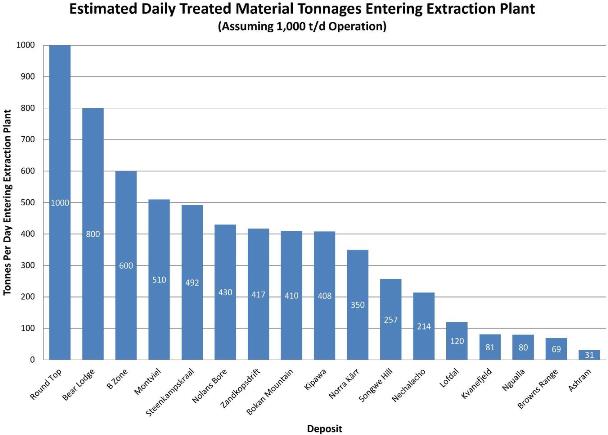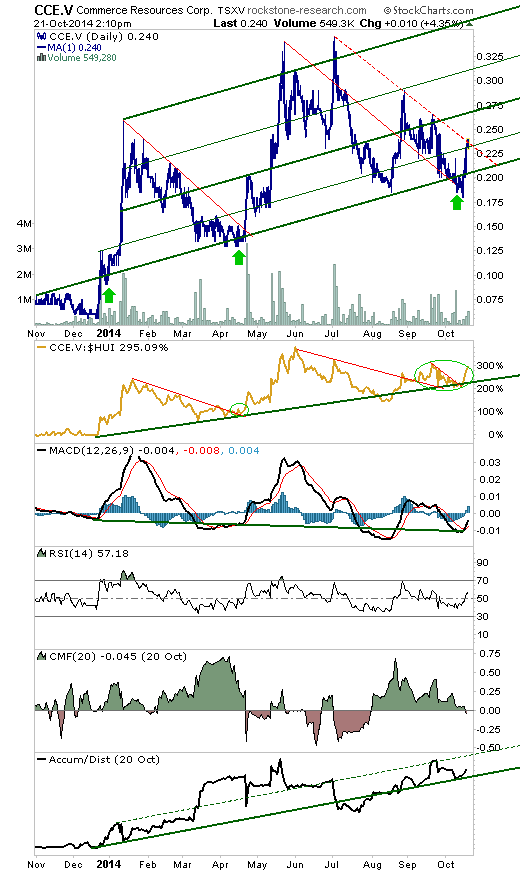Disseminated on behalf of Commerce Resources Corp. and Zimtu Capital Corp.
As our prior series of articles endeavoured to convey, the rare earth space is complicated with many facets that need to be evaluated to properly assess the quality of a development project (mineralogy/metallurgy, grade/tonnage, rare earth element (REE) distribution, economics, infrastructure, jurisdiction, etc.).
In this piece I would like to focus the discussion on the two contrasting “Mine-to-Market” business strategies prevalent in the space, in an underlying effort to understand the reasoning behind choosing one or the other, and to hopefully gain additional project insight. After all, there is a possibility that even a quality project may fail if a poor ‘mine to market’ strategy is followed by company management.
I will also try to illustrate how, in my opinion, the primary driver in the business strategy decision making process is the depositÂ’s amenability, or lack thereof, to beneficiate to an REE mineral concentrate and the resultant decrease of the downstream capital and operating expenditures.
All REE projects in development may be generally categorized into two main mine-to-market business strategies or models:
A) Process through to separated rare earth oxides (SREOs), or
B) Process through to an intermediate product that is saleable, or tollable, into the market (i.e. mixed rare earth oxide, mixed rare earth carbonate, mixed rare earth chloride)
Each strategy will have its own pros and cons, and these attributes will relate back to the nuances of each individual project, most importantly, the mineral processing and hydrometallurgy. So the natural question is:
Which strategy is more economically sound?

Evidence suggests that if a company has chosen Strategy A, processing to SREOs, it will face numerous additional challenges when compared to a company that is focused on Strategy B, processing to an intermediate saleable product. Some of these challenges include:
(1) Increased capital expenditure (CAPEX) for the construction of the solvent extraction (SX) facility (also termed “separation facility”).
(2) Increased operating expenditure (OPEX) for the facility.
(3) Tighter product specification tolerances.
(4) Lengthy product qualification process with potential customer(s).
(5) Individual SREO products may inadvertently decrease the pool of potential buyers because of tight, customer-tailored specifications.
Of course any business plan can be fraught with challenge and correspondingly, if a company has chosen Strategy B, processing through to an intermediate product,they may have the following challenges compared to processing through to SREO:
(1) The potential pool of buyers is limited to those with separation capacity, or those with access to separation capacity.
(2) The mixed product sale price must be discounted as REO separation is not complete.
(3) Pricing for intermediate products is not as transparent compared to SREO.
A review of junior REE exploration companies illustrates certain popularity to both strategies. Therefore, a more detailed discussion is in order.
Processing Through to SREO
(Strategy A)
Company management following the strategy of processing through to SREO typically have a CAPEX of well over $1 billion and in some cases over $1.5 billion, with the SX facility often the largest single expenditure of the entire project; commonly at a cost of $200 to $600 million depending on the production scenario, REE distribution, and REO purity desired.
Further to the economic picture, the OPEX of the SX circuit in the separation facility is considerable, and invariably is where the largest OPEX will be apportioned for the project. This is dominantly related to the increase in consumables (power, reagents, etc.), as well as related shipping and handling. For example, the SX processing may range from $5/kg REO produced for the light rare earth elements (LREE) through to >$25/kg REO produced for the heavy rare earth elements (HREE).
A common statement by companies processing through to SREO is the attempt to relate the “big finance” difficulties to the terrible market conditions over the last 3 years; however, this is perhaps a specious argument and the real criteria that should be used is whether a company has produced a flow sheet that makes economic sense.
An often overlooked aspect, when producing SREO products for the market, is a) the tight REO purity and impurity (Th, U, Ac, Pb, Cr, Si, Na, Al, Zr, etc.) tolerances required by any potential customer, as well as, b) the subsequent qualification process for the customer to conclude the product meets their specifications for a long enough period of time – essentially quality continuity of the SREO product(s). Achieving the proper purity for each SREO may have a significant impact on OPEX, as well as general development costs of the flowsheet in order to first attain it. In other words, the tighter the specifications, the greater the cost input and time to achieve it. This essentially compounds the project risk.
Once a product is produced, the qualification process may take up to two years to complete as not only does the customer require confirmation that their specifications have been met, but rather that they can be met consistently. Such high-level requirements mean customer relationships must be developed over time, with an equally high level of comfort achieved between the parties. There is a common misconception in the space that if you can produce separated REO of a 3N or 4N purity (99.9% or 99.99%), you can sell it readily to end-users, while in actual fact, this is far from reality. I believe this to be perhaps the most underestimated hurdle of any project processing through to SREO, and a definite showstopper if not properly and technically addressed during the development stages, as well as through fostering those required customer relationships.
Another aspect to consider is niche application, customer-specific individual REO production. An REO rare earth SX facility is a complex entity with over 1,000 stages of processing required for complete separation of all fifteen REOs, depending on desired purity. This may equate to over 80 stages to separate just one REO from another (termed a ‘battery’), and once set up, is a material task to modify. Therefore, the set-up and integration of these batteries effectively commits to a specific stream of production and targeted purity. This may inadvertently limit the pool of potential buyers for that stream of production, due to set customer-tailored specifications that do not always equate among their peers. This drawback may be amplified if more than one customer is needed for sale of all the production of a specific REO, or the production in its entirety for that matter.
Processing Through to an Intermediate Product
(Strategy B)
As the rare earth space is complex, it may be argued that the company that has produced a simple flow sheet that makes economic sense may have the ability to be the first to achieve production.
As such, an optimal way to approach SREO may be to first produce and sell a mixed REO intermediate product to a third party with separation capacity. Such a strategy would allow for potential economic success at an earlier point and would avoid the large upfront cost and time to qualify the process and relationships required for success of processing through to SREOs. This would also further de-risk the project by avoiding any inflated CAPEX/OPEX concern.
Although the potential pool of buyers for an intermediate product is generally limited to customers with separation capacity, there is demand for feedstock covering a reasonable range of REE distribution. Pricing may not be as transparent to the market as with individual REO as each intermediate product will have its value reflected in its own unique REE distribution and contract specific to each. However, if the product of sale can be produced and sold at a healthy operating margin, the project would still be considered financially sound, and perhaps, readily financeable.
Alternatively, it is well-known in the space that there is significant excess separation capacity in and outside of China. Tolling, for example, would mitigate the risk of added CAPEX that often precludes a “big capital” investment to put a project into production, yet still allow for increased margins. The qualification process would also largely be mitigated as the SX facility would have developed customer relationships and demonstrated ability to achieve the required tolerances. It would also be in the tolling facility’s best interest for the source of their feedstock to have secured offtake allowing for them to act as a bridge to high-level producer-customer interaction.
In essence, a tolling agreement between an REE junior company producing an intermediate product and an REE processor has the potential to open the ‘floodgates’ in terms of available off-take interest (e.g. magnet manufacturer, phosphor industry, automotive industry). This makes tolling a potentially attractive option for attaining vertical integration (mine to end-use) without the large additional CAPEX-OPEX layout. However, few companies attempt this strategy to unlock additional margin upside. This may partly be explained by the difficulty some projects may have in finding a facility that would accept their feedstock REE distribution. For example, there are significantly fewer HREE SX facilities compared to LREE SX facilities in the world.
One disadvantage an intermediate product has compared to an individual REO product is pricing transparency in the public domain. This ‘disadvantage’ has its most readily seen effect in the economics of companies adhering to Strategy B in that they typically factor in a discount to the pure oxide values, used by companies adhering to Strategy A; this can have the effect of a company using Strategy B being appropriately conservative on values but not being understood as such.
Individual REO pricing information is simply more readily available compared to that of an intermediate saleable product, as this is the standard measure of pricing in the space. The REE distribution, unique to each intermediate product, will result in a unique saleable value, making pricing opaque for most mixed REO products. However, through contracts companies can secure accurate pricing information for their intermediate product specific to their deposit. The “basket price” measure, which is so common in the space, is inherently flawed and often used improperly as a metric of comparison. Be mindful of companies pushing a high basket price above most other metrics.
Additionally, there may be a possibility that a company that has achieved positive economics with Strategy B could always develop towards a fully integrated facility for direct SREO production and sale.

The Underlying Motive
In my opinion, when contrasting the two business strategies, it becomes apparent that the approach with the greater potential for success is the simple and low-cost strategy of producing an intermediate product first before contemplating separation of individual REO. To do otherwise would be a clear underestimation of the difficulty with REO separation. The basic idea being, itÂ’s wise to get ones feet wet before jumping head on in.
Pursuing individual SREO for a junior company on its own seems like a considerably higher-risk venture, with tighter product specifications and typically inflated CAPEX/OPEX. This seems like a more problematic approach for any management team in the REE space to pursue, regardless of market conditions.
Yet, here we are in 2014 with significantly lower REE prices than the peaks attained in 2010/2011, (albeit much higher than just 6 years ago), and still there are numerous high-profile companies still proposing to construct and operate, on their own, SX facilities as part of their mine-to-market business strategy. Some have even revised their strategy to now include a SX facility when one was not present prior.
This begs the question: Why would a company choose Strategy A?
Based on my experience in the space, I suggest there are only three reasons why junior companies choose to process through to SREO:
(1) The successful joint venture with an industry partner,
(2) The belief that the operating margins are more attractive and would offset the increased CAPEX/OPEX,
(3) The company has no choice as the projectÂ’s margins are not compelling enough unless SREO separation is completed.
The first suggested point, being the involvement of a joint venture partner, has the most merit and is the optimal approach. Such a joint venture partner might be a trading house, or magnet manufacturer. Rare earth companies that are pursuing this strategy will have a sound business model assuming they have a deposit that warrants the attention.
The second point, the potential for more attractive margins through the realization of SREO pricing at market, is perhaps another compelling reason. This refers to the China FOB (Freight on Board) market pricing for the individual REO, as opposed to the discount that companies must apply to this price if only selling an unseparated, mixed REO product. The reason, of course, infers that the margins for an intermediate product are marginal and, hence, not that attractive compared to SREO for that particular project. I believe companies following this logic vastly underestimate the space in its entirety and perhaps do not recognize the trade-offs they are committing themselves to.
Taken a step further, the project may not be economic unless higher margins are attained. In other words, the project would not be economically viable unless those added margins from SREO are incorporated into the economic model at the risk of increased CAPEX/OPEX, which may make satisfying a debt facility questionable. However, processing through to SREO in order to achieve adequate margins for project advancement is clearly not an ideal route to be forced down. This would suggest that the project is not economically versatile and further suggests it may be of questionable quality and difficult to develop with very little margin for error.

This brings us to the third point and a review of the space reveals that companies planning on proceeding to SREO on their own typically have deposits with complex mineralogy, often with REE minerals that have never been commercially processed. I hypothesize that such complex and difficult metallurgy is the underlying motive for processing through to SREO, and moreover, that these projects are not financially flexible enough to follow any other mine-to-market business strategy.
I believe this is directly related to ease of ore processing and REE mineral concentration, and the subsequent consumables impact on overall project economics. If one can reduce the mass to be processed entering the extraction stage, the largest consumable input and OPEX source is reduced (i.e. the acid), and the economics improved allowing for a simpler mine-to-market strategy to potentially be viable, dramatically increasing the potential of being financed for production.
Therefore, in my opinion, the only logical reason to choose either Strategy A or Strategy B is directly related to the projectÂ’s flowsheet.
A simple and low-cost flowsheet with a readily marketable product is the path to success in the REE space I argue, while a complicated flowsheet leads one down the path of separation, added technical difficulty, and potentially insurmountable, marginal economics.
Throughout this series of articles I have noted Commerce Resources Corp.Â’s Ashram Deposit as my top pick in the space for success. This goes beyond the technical attributes of the project that I have discussed in detail while in comparison to other projects; it is also directly coupled with managementÂ’s business strategy and overall understanding of the REE space. CommerceÂ’s management has shown an unwavering commitment to finding a strategic partner to maximize shareholder value while at the same time is working towards a simple, low-cost, and practical path to production by way of an intermediate product.
There is an age old saying of something along the lines of “a poor project in the hands of great management is better than a great project in the hands of poor management”. I feel Ashram is a great project in the hands of great management and this is a combination which typically leads to production.
Compared to its peers, Commerce has climbed in market cap since December 2013, whereas, most others continue to slide. A testament perhaps, to the growing realization that Ashram is a game changer in the REE space.
A Segue of Sorts
Since the flowsheet is typically the primary driver that determines the economic viability of the project, and may be the primary motive for the business strategy direction as noted above, a discussion of the common components of a flowsheet and their nuances may help elucidate why a project is forced down a certain mine-to-market strategy path.
However, as the great playwright William Shakespeare once penned, “Brevity is the soul of wit”, and as such, I will leave this subsequent discussion to the next
article and will end this piece with the following illustration to ponder project versatility.
The illustration below may be used to infer which projects are likely to have the ability to operate at lower-cost during downstream processing, and therefore, have the most versatility in terms of business strategy. A mining operation of 1,000 tonnes of ore per day is assumed to show the resulting daily feed volumes that would enter the extraction facility for each project, based on their ability to physically upgrade to a mineral concentrate.

The projects with the least amount of volume entering the extraction facility are most likely to be processed downstream at the lowest cost.
Based on this method, Commerce ResourcesÂ’ Ashram Deposit is the clear leader with less than half the volumetric input as the closest peer.
On October 17, the investment bank Secutor Capital Management issued a readworthy research update on the REE market and the feats of the Ashram Deposit.

Disclaimer: The author, Stephan Bogner (Dipl. Kfm., FH), owns shares of Commerce Resources Corp. and thus would profit from a share price appreciation, whereas the author may sell those any time without notice. Neither Rockstone Research nor the author was remunerated or instructed by Commerce Resources Corp. to produce or publish this content. However, please read the full disclaimer within the full research report (available as a PDF below) as a conflict of interest exists with Zimtu Capital Corp. and none of this content is to be construed as a "financial analysis" or "investment advice".
